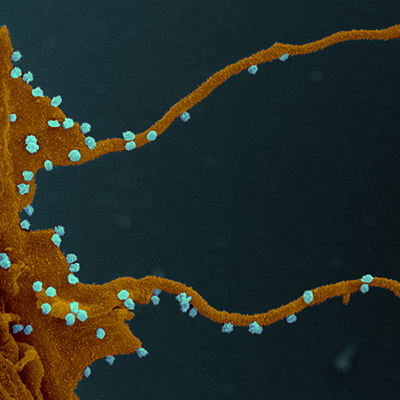July 20, 2020 -- A SARS-CoV-2 protein, N-terminal nonstructural protein 1 (Nsp1) , may play a critical role in weakening antiviral innate immune defenses, according to a study published in Science on July 17. Researchers identified how the viral protein specifically shuts down host protein production and subsequently blocks host immune functions.
Following host infection, precursor proteins are proteolytically cleaved into functional proteins that are vital for viral replication. Among these proteins is Nsp1, which plays a role in suppressing host gene expression. Nsp1 achieves this with a two-pronged approach including binding to the small ribosomal subunit to stall messenger RNA (mRNA) translation at various stages during imitation and binding to the ribosome for endonucleolytic cleavage and degradation of host mRNAs.
Furthermore, Nsp1 interacts with the 5' untranslated region of viral mRNA to protect viral protein expression. Cumulatively, Nsp1 plays a role in shutting down key parts of the innate immune system and weakens host antiviral immune responses.
In the current study, German researchers described how they sought to characterize specific interactions of Nsp1 of SARS-CoV-2 with human translation machinery.
The researchers started by exploring how the Nsp1 of SARS-CoV-2 bound to the ribosome. Mutant versions of the virus, lacking the K164 and H165 C-terminal residues, which are conserved and essential for binding, showed no binding to subunits of the ribosome, thus confirming their crucial function in ribosome binding and translation inhibition. Specifically, K164 and H165 residues of Nsp1 form salt bridges and hydrogen bond interactions that rigidly anchor Nsp1 and consequently obstruct the mRNA entry channels on ribosomes.
Next, the researchers used cryo-electron microscopy to determine the molecular interactions of SARS-CoV-2 Nsp1 with human ribosomes. When the C terminus of Nsp1 is bound to the ribosome, it is able to block regular mRNA from binding. Structural analysis revealed that in all conformational states, the Nsp1 C terminus binds in an identical position and conformation, corresponding to lack of mRNA binding.
The team also found that Nsp1 forms stable associations with the 40S ribosomal subunit that contributes to inhibition of translation initiation. Furthermore, they found that Nsp1 binds to the mRNA entry channel of translationally inactive 80S ribosomal subunits, which plays an unknown role in inhibition processes.
Lastly, the researchers explored how SARS-CoV-2 Nsp1 impacts the interferon system. They found that Nsp1 expression completely blocked translation of retinoic acid-inducible gene I (RIG-I) and interferon-stimulated genes (ISGs) in vitro in contrast to mutant viruses, which showed no such effect.
"Our data establish that one of the major immune evasion factors of SARS-CoV-2, Nsp1, efficiently interferes with the cellular translation machinery resulting in a shut-down of host protein production," noted the authors.
Therefore, major parts of the innate immune system that depend on translation of antiviral defense factors, such as interferon-beta or RIG-I, are disabled.
The authors suggested that Nsp1 inhibitors may render SARS-CoV-2 vulnerable toward immune clearance and provide a starting point for rational structure-based drug design that targets Nsp1-ribosome interactions.
Do you have a unique perspective on your research related to virology or or molecular biology? Contact the editor today to learn more.
Copyright © 2020 scienceboard.net










